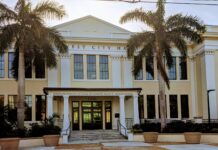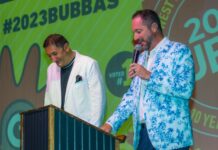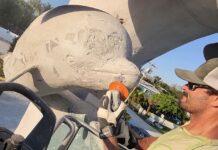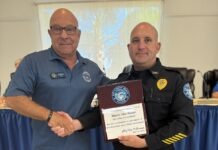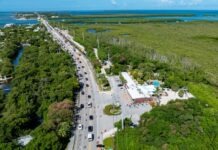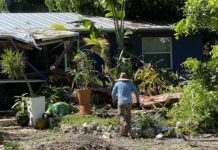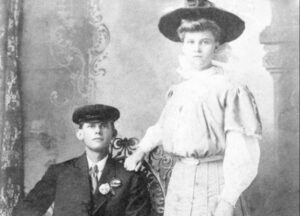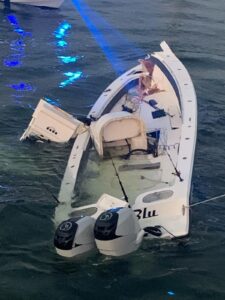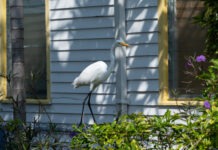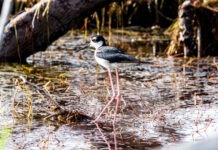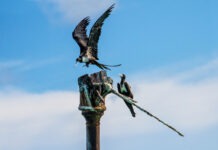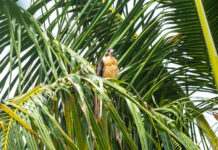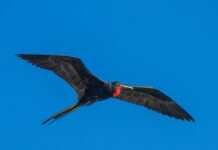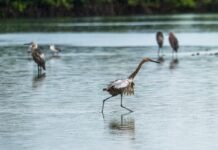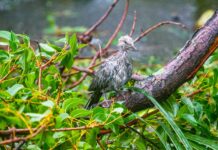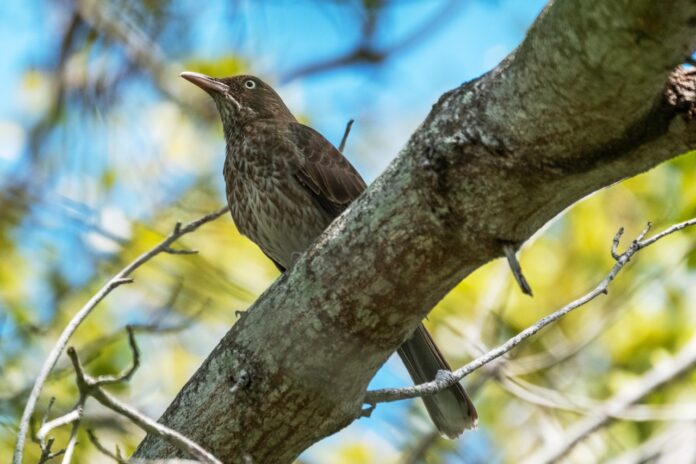
I’d just watched three or four videos about how to properly tape drop handlebars on a bicycle, which apparently gets really tricky around the brake levers.
I felt I had the technique down in concept, but wanted to take a break before I went and real-world screwed it up on my actual bike, so I spent a few minutes scrolling through Facebook. Mostly it was the usual political jeremiads, as well as memes offered as behavioral correctives, but after 30 or 40 such things, I saw something interesting.
There was a post, literally from a minute before, about a pearly-eyed thrasher at the Key West Tropical Forest & Botanical Garden. They’d included a grainy photo.
A pearly-eyed thrasher is common in much of the Caribbean, though not in Cuba and still somewhat rare in the Bahamas, where it has been increasing. The species has never been reported in North America.
Honestly, I’m always a little skeptical when someone reports an amazingly rare bird in the Keys, largely because we get so many visitors unfamiliar with the area, a small number of whom are very determined to see an amazing bird. Not to mention I’d seen broadly similar-looking brown thrashers breeding at the botanical garden a few years ago, and that seemed a lot more likely.
There’s a common dictum in journalism: “If your mother says she loves you, check it out.” I feel this applies to rare birds, too. It’s in everyone’s interest not to take things on faith.
Also, I really didn’t want to put on shoes and socks, get in the damn car and drive all three-and-a-half miles out to Stock Island if I didn’t have to.
The woman who posted about finding the bird was named Emily Guarino. A little Googling let me know that she was a scientist and trainer at the Dolphin Research Center on Grassy Key. Which gave me hope that my skepticism was a bit unwarranted.
The photo she posted was grainy, but even in bad light it was clear the bird wasn’t rufous enough to be a brown thrasher. Also, brown thrashers have saffron yellow eyes. This bird’s eyes were, in fact, pearly white.
I quickly looked up all the other thrasher species that have been seen in North America, and it wasn’t any of those, either.
Guarino had posted the photo on the Facebook page, Florida Rarities and Bird Migration, where members would deconstruct a bad identification, especially of a mega-rarity, pretty ruthlessly and quickly. Congratulations were being offered all around. Several people were saying they’d expected to see this bird show up in Florida for years now.
On the American Birding Association’s scale of rare birds, a pearly-eyed thrasher was a category 5 out of 6, and 6 was extinct.
I texted a few people, then went to find my shoes and socks.
I met Mark Whiteside in the parking lot and went in. Guarino said the bird had been seen in a gumbo limbo two right turns from the entrance. When we made it to the tree we ran into Matthew Jolley, who’d also seen the post.
We stared into what we thought was the right tree until we were sure it wasn’t in there, then we began to look about a bit. I’m not sure how long it was. Five minutes? Fifteen? Then Jolley said, “There it is,” lifted his camera, and took a few shots while trying to explain to us where it was.
Whiteside and I were both looking in the wrong tree further down the boardwalk, and it hopped down before either of us got a look, but Jolley showed us a really good shot he got of the bird, which didn’t make me feel at all simultaneously jealous, petty and covetous.
Jolley got us on the right tree, though, and a few minutes later the thrasher popped up. It even stayed up long enough for me to get a decent shot myself, before dropping back down into the thicket.
Ellen Westbrook arrived, and we told her how we’d just seen the bird 10 minutes before, and no doubt it would pop up again, though that turned out not to be the case.
I didn’t get to the botanical gardens until an hour after it opened on Monday. The parking lot was already full and I had to park out on the road, as there were already about 40 birders there. I knew some of them, but hadn’t seen them since before the pandemic, and there were a good number of birders I’d never met. Most were from Florida, or from elsewhere and happened to be in Florida when the bird was put up on the ABA’s Rare Bird Alert.
Emily Guarino was also there, birding with Mary Stella, who recently retired from the Dolphin Research Center. So I asked Guarino to sit down on a bench for a few minutes and tell me about finding this amazing bird.
She said she’d come down to Stock Island with her husband Mike Guarino because migration was starting and they wanted to see some warblers. Which they did. And also a lot of gray catbirds eating berries in the gumbo limbo near the entrance. And just out of the corner of her eye, she saw something that looked just a little … different.
“We both got our binoculars on it, and immediately knew this was not a species we’re used to seeing here. And so we watched it for a good long while, just reciting field marks to each other, memorizing them, so we could then ID it in a guide,” Guarino said.
“I knew what it wasn’t. I knew it was thrasher-like, but I knew it wasn’t a brown thrasher. I knew it was about the size of a Bahama mockingbird, but it wasn’t that,” she said.
“We’ve lived here for over 20 years and we knew what it wasn’t. So then it was just a matter of taking in and reciting and memorizing field marks so we would be able to identify it together. We were calling things out to each other, like large pale bill, dull upper parts and white underparts with brown streaking. Things like that so we could confirm what the other person was seeing,” she said.
“It was really useful, in this circumstance, to have two different birders, noting and settling on the same field marks. And then we felt confident,” she said.
The grainy photo she posted was one she’d shot with her iPhone, which to me counts as 10 out of 10 for difficulty.
“It was a good lesson as a birder. Don’t overlook things. Don’t just assume it’s another catbird or something like that,” she said.
Sadly, the pearly-eyed thrasher was not seen again Monday or Tuesday. My guess is it will pop up again, maybe at the botanical garden, maybe somewhere like Fort Zach or Indigenous Park. But that’s just a guess.
